Even when the worldwide economy is affected by a slowdown, the healthcare industry continues to grow. Needless to say, the COVID pandemic has affected healthcare too — with the unbearable burden it has placed on the industry’s shoulders, all participants have been made aware of the deficiencies in healthcare.
One of the tools offering new possibilities to healthcare facilities is the Internet of Things, or IoT. It helps healthcare organizations deal with the challenges of an increased workload, while enhancing the efficiency of medical procedures and business processes in a hospital or other medical facility.
The upgraded version is a smart hospital — an IoT-enabled hospital with tons of new features and benefits to both caregivers and patients.
In this article, we will take a closer look at the following topics:
- What is a smart hospital? Definitive differences between a traditional and a smart one.
- Benefits of smart hospitals: What they have to offer to caregivers and patients.
- How to make a smart hospital: Tools and approaches, IoT solutions in healthcare.
What is a Smart Hospital
A smart hospital is a hospital that optimizes or redesigns traditional clinical processes with the help of information technologies and advanced hardware. Sometimes, new processes and management systems are built from scratch in such hospitals.
Smart hospitals allow for better patient care, operational efficiency, and a better overall experience thanks to the use of digital infrastructure. IoT medical solutions can transform hospitals into smart hospitals.
Traditional hospitals turn to smart solutions for two main reasons: increasing demand for high-quality healthcare services and growing pressure on the healthcare system caused by population growth. Both factors contribute to rising costs, which can be managed to some degree by creating a smart hospital.

Digitalization processes within hospitals are an integral part of the digital transformation of the healthcare industry as a whole. We’re not just talking about making hospitals paperless. What makes them truly smart is the ability to provide valuable insights and ultimately a complete realignment of all processes and management systems.
- Remote medical care
- Enhanced patient safety
- Seamless patient flow
- Cyber resilience
- Improved diagnostics and surgical ability
- Trustworthiness
IoT technologies in healthcare help achieve all these objectives by providing hospitals with advanced sensing gadgets and secure data networks.
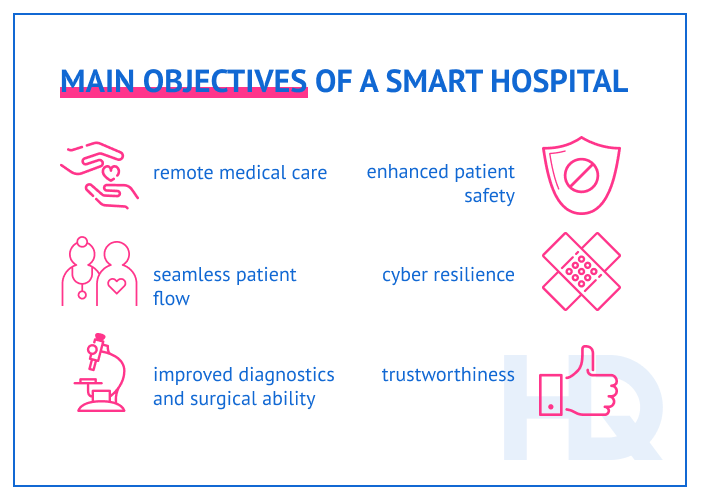
Now, let’s dig deeper into the benefits smart hospitals offer and what exactly differentiates them from traditional medical facilities.
Benefits of Smart Hospitals
The benefits of smart hospitals extend to everyone concerned — caregivers, patients, healthcare businesses, even insurance companies. Here are some of them:
Shorter waiting times for patients and caregivers
Hospital intake staff carry a lot of responsibilities: they book appointments for patients, answer phones, greet and coordinate visitors, deal with paperwork, and so on. The workload itself often creates a bottleneck that causes longer wait times and service delays.
At smart hospitals, all data about incoming patients and services is added to the customer management system before their arrival. The smart infrastructure also includes services that allow online check-in and remote payment for car parking, alert hospital staff about arriving patients, and so on.
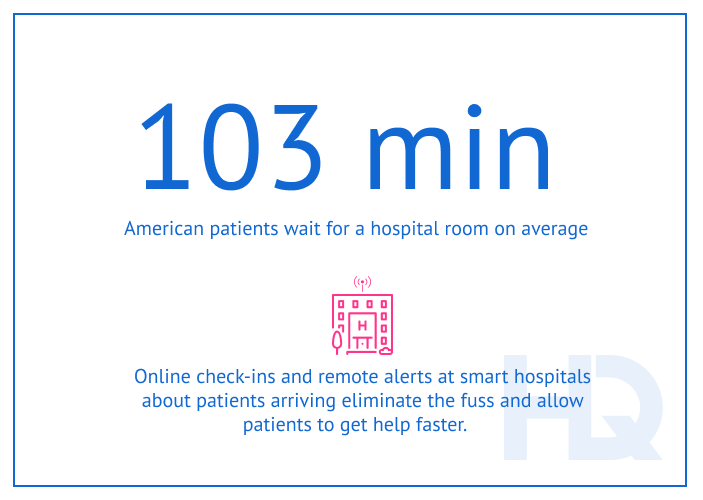
According to statistics collected by the Centers for Disease Control and Prevention, about 40% of American patients wait about 15 minutes before they see a nurse or a physician after they check-in at an emergency room department, and then an average of 103 minutes waiting for a room. Online check-ins and remote alerts about patients arriving eliminate the fuss and allow patients to get help faster.
Better patient experience
IoT medical solutions offer features that upgrade hospital rooms and take the patient experience to the next level.
Wearable and in-room sensors, monitors, and mobile devices help to improve patient-doctor communication. Sensors, for example, can collect data about a patient’s health so that the doctor is constantly updated on the patient’s current health status. This allows for a quick response, for example when there is a significant change in blood pressure, by doing an in-person examination or prescribing medication.
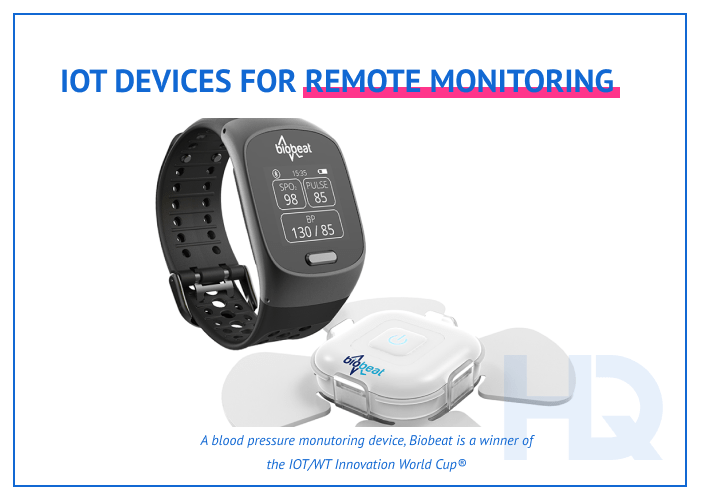
For patients, IoT medical devices offer accessible data on their treatment, blood test results, current health status, and so on. This eliminates guesswork and helps reduce patients’ anxiety about their health.
Location services
With IoT solutions for medical organizations, hospitals can track the location of staff and critical equipment, e.g. heart monitors, defibrillators, and so on.
Small, lightweight IoT sensors and trackers, worn by staff or attached to equipment, constantly send data about their location, so they can be found easily when a critical situation arises.
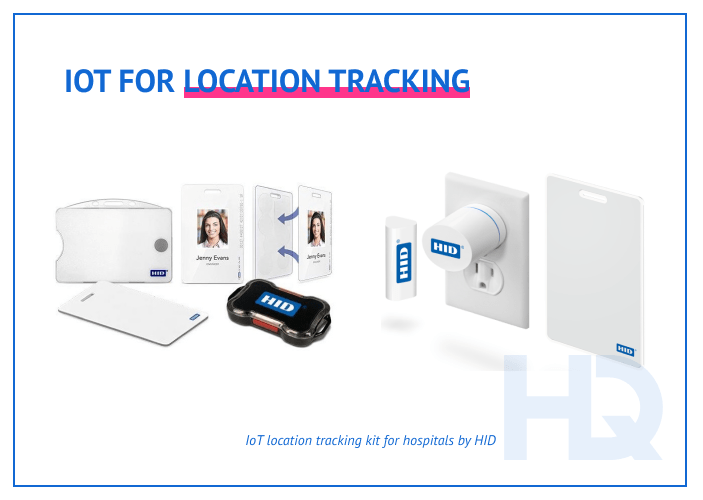
IoT services can also be used to help patients and staff find the right route to any location in the hospital. For example, patients can use apps that draw a path to the required room while collecting data from trackers that see the user’s current location. Older patients can also benefit from such an approach — the path can be drawn in such a way that it avoids busy hallways and stairways.
Self-service
IoT medical solutions can relieve hospital staff from certain responsibilities by automating routine tasks, which are often non-medical. Tablet-like devices and kiosks can be installed around the building for patients and guests to use by themselves.

For example, patients and doctors can adjust lighting, heating, and air conditioning in their hospital rooms independently and without additional assistance. All devices that control the climate in the room can be connected to the IoT network and controlled locally via mobile devices or voice commands.
Kiosks in the reception area and hallways can carry out similar tasks:
- help users navigate;
- answer questions;
- help find staff, rooms, and equipment;
- make online doctor appointments, and so on.
Enhanced security
For security and surveillance, IoT has tons of features to offer.
With IoT solutions for medical organizations, hospitals can be equipped with top-notch security systems:
- Facial recognition to ensure no unauthorized people are allowed into restricted areas
- Intelligent analysis of data from cameras and automated detection of suspicious activity
- Smart door lock systems
- Intelligent power regulation devices
- Smart fire detectors
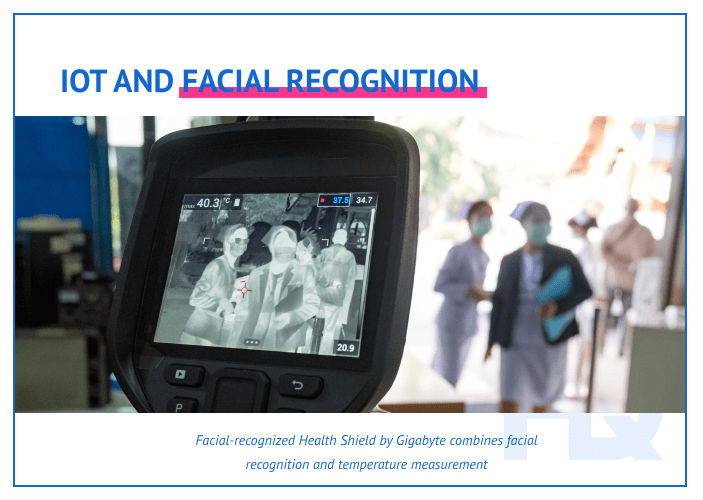
If we were to emphasize one advantage of the smart hospital that encompasses all of these, it would be that with IoT, hospitals can take advantage of current and future technologies to develop a “smart brain.”
That “brain” is a huge network of interconnected devices that send and receive crucial data that can be used to enhance hospital processes. That’s a critical advantage smart hospitals have over traditional ones.
Now let’s see what it takes to build a smart hospital and develop IoT medical solutions.
Making Your Hospital Smart
First, let’s unpack the design of a smart hospital built with IoT technologies in healthcare.
The first step to making your hospital smart is to identify who will make use of the future system. Will it be doctors and patients only, or hospital management and insurance companies as well?
Then, identify how data will be treated:
- Which data is collected and shared in the system and how?
- Which data will be analyzed and how?
- How will data be delivered to users?
Once you’ve answered these questions, you can start designing a smart hospital.
Design of a smart hospital
The design is often described as a set of layers:
- Sensing layer
- Networking layer
- Remote servers layer
- Knowledge layer
- Applications layer
Diagrammatically, it could look like this:
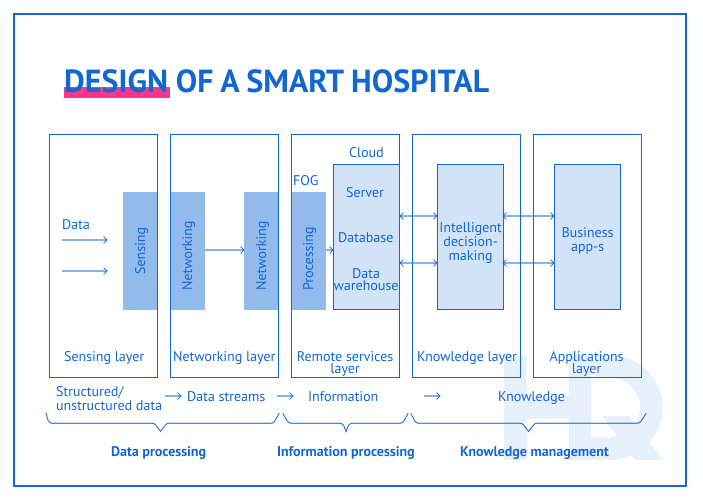
We will start with the sensing layer, as it is the most crucial one in the infrastructure of IoT medical solutions for smart hospitals.
Sensing layer
This term incorporates all the sensors and tracking devices that are used to collect data on numerous factors, from patients’ health to equipment location.
- Wearable sensors: small devices users carry on themselves. They include sensors measuring heartbeat and blood pressure, spirometers, and so on.
- Ambient sensors: devices installed around the building to track environmental factors: temperature, humidity, light, noise, etc.
- Location sensors: devices that track the location of equipment and people: RFID, beacons, infrared sensors, binary sensors that track window or door contacts, light switches, etc.
- Implantable sensors: installed inside a human body for advanced care and monitoring: gastric stimulators, insulin pumps, brain stimulators, and so on. These are usually equipped with Artificial Intelligence that makes independent decisions about patient care, relieves doctors from certain tasks, and transmits patient data to the hospital database.
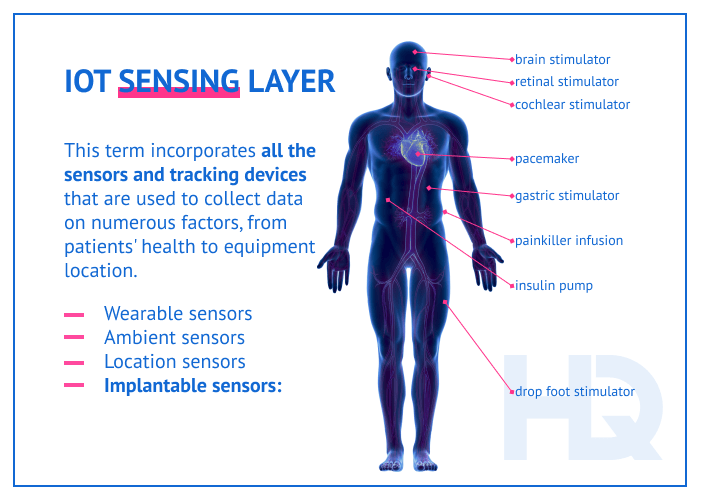
The sensing layer specifies exactly how the smart hospital system monitors, stores, and analyzes healthcare-related data. At this layer, it is important to address optimization problems — issues regarding the frequency of data collection, chosen technologies, and approaches to obtaining data require special attention, so hire IoT developers with distinct experience in this area.
IoT solutions for smart hospitals in healthcare – custom development at your service
HQSoftware has a team of skilled professionals ready to tackle the project. Let’s talk!
Julia Tuskal
Head of Sales
at HQSoftware
An adequately built IoT health management system with a well-thought-out sensing layer will make it easier for the organization to make good use of data. For example, when an insurance company wants to know the health status of its client for life insurance purposes, the hospital can easily provide this data.
Developing a sensing layer also requires building in a certain level of personal data protection, so it’s better to hire seasoned IoT developers who can approach and resolve issues such as the reliability of data, hacker attacks, and energy consumption.
Another issue related to data is that a sensing layer consists of numerous devices that generate an enormous amount of real-time data of different formats. Uploading that amount of raw data directly to the smart hospital system would certainly produce a decrease in performance and a delay in all data processing operations.
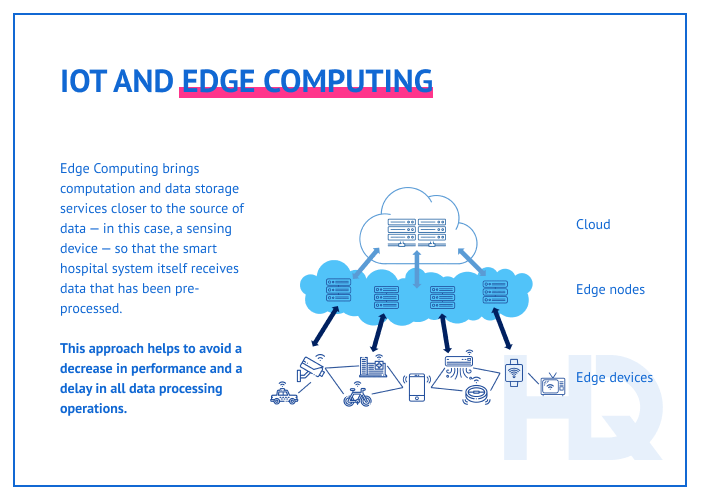
To solve this, medical IoT developers typically choose edge computing. This approach brings computation and data storage services closer to the source of data — in this case, a sensing device — so that the smart hospital system itself receives data that has been pre-processed.
Networking layer
The networking layer specifies how data is transmitted inside the smart hospital system. The design of this network must ensure that the network is able to work for a long time and adequately collect, analyze, and transmit large amounts of data.
To build a proper networking layer, hire experienced IoT developers who will define the following parameters:
- Communication types. IoT devices interact with each other within a homogeneous or heterogeneous network, and the types are human-to-human, human-to-machine, or machine-to-machine.
- Network protocols. Various types of network protocols differ in power consumption, security, ability to provide real-time updates, and so on.
- Connection technologies. Developers should select the appropriate technology that ensures communication and interoperability between devices.

Main issues to solve:
- Lack of a widely accepted common platform that works well with various IoT apps;
- Possible security breaches and protection from attacks;
- Managing a large number of devices connected to one network simultaneously.
- Personal data privacy and confidentiality during information sharing.
Remote servers layer
This layer deals with numerous simultaneously connected devices that interact with each other in a distributed environment. To build a properly thought-out remote servers layer and make your hospital smart, developers should consider the following:
- Computing technologies. Developers set up computing technologies for apps that require external computing and warehousing of data. Possible options are edge computing, fog computing, cloud computing, etc.
- Nodes, or devices. To ensure remote servers work as intended, developers need to identify which nodes are central or cluster and a base station. Done properly, this step ensures lower energy consumption, eliminates excess network connection, and sets data communication over the shortest distance.
- Information processing. Developers make sure all data is processed correctly, taking into account the accuracy, provenance, and trustworthiness of IoT streams. For medical systems in particular, it is crucial to identify whether data sources and the information itself are reliable and accurate.
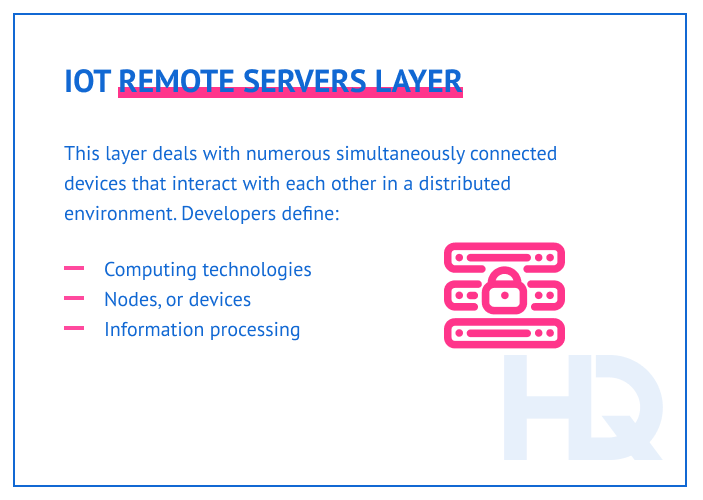
A proper design of this layer ensures that this whole structure is able to provide server access to all medical IoT devices wherever they are located.
Knowledge layer
This is the layer where all the “intelligent” decisions are made. Smart healthcare systems utilize advanced intelligent technologies to transform data processing and analysis into automated and insightful processes.
For example, smart hospital systems benefit from using Artificial Intelligence, robotics, and other cutting-edge technologies for personalized risk assessment, accurate diagnostics, and other vital purposes.
At the knowledge layer, developers have to decide the following:
- Appropriate intelligent technology. Hospital requirements differ, and it is important to support smart healthcare systems with appropriate technology: Machine Learning, AI, autonomous IoT structures, and so on.
- Knowledge Processing Approach. Developers choose between data-driven, knowledge-based, and hybrid approaches to achieve the best results in making the system take automated actions and identify predictions.
- Database. Creating an efficient data management model affects the whole process of data collection and processing, as an appropriate data warehouse has to translate various types of incoming healthcare-related data into one single format.

Applications layer
This layer is fully dedicated to the design of practical applications for every party that uses smart hospital systems. The three main steps are:
- Application design. Applications grant access to different data depending on predetermined authorizations; for example, doctors can access all health-related data about their patients but will not see some of the insurance information.
- Service platform. This is where practical applications and authorization levels meet. The platform incorporates all applications, including those for doctors and physicians, the emergency care unit, the insurance unit, patients, management, and so on.
- Technologies. This step includes all technologies used at the smart hospital, e.g. m-health, e-health, telemedicine, etc.
In this layer, developers create graphic interfaces for applications that obtain data from lower layers to perform all services, including sensing and data refinement through interaction with users. Also, with this layer users can access data-related graphs and other reports.
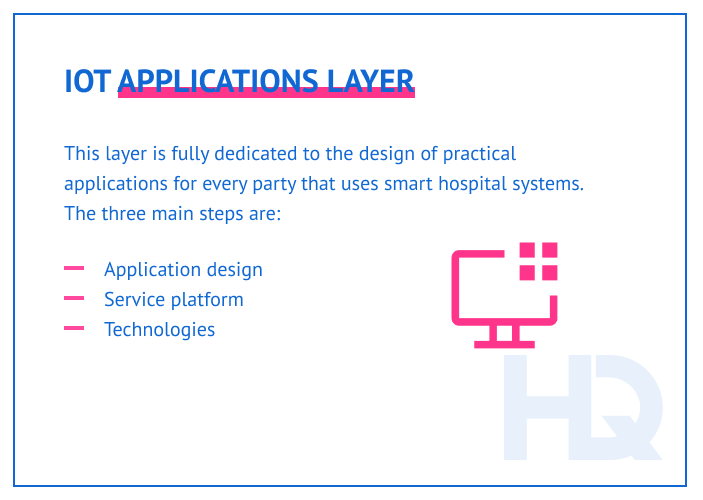
Authentication, authorization, and data delivery and security processes need to be developed with extra attention in order to grant correct access to information and ensure the system works properly.
Inadequate smart hospital design causes trouble, to put it mildly, and the hospital then has to deal with an enormous number of negative effects.
On the other hand, a perfectly designed smart hospital is an extremely efficient ecosystem of hardware, software, and data that brings tremendous benefits to the hospital itself, patients, and caregivers.
Areas that smart hospitals address
Smart hospitals address the following areas:
- Operational efficiency
- Clinical tasks
- Patient-centric approach
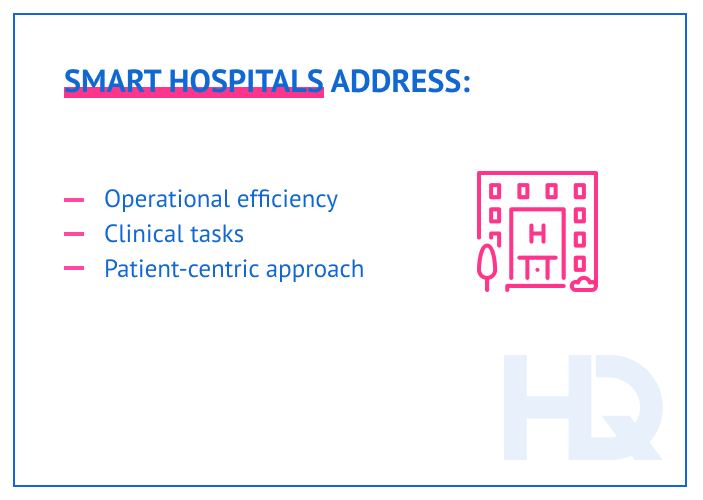
For operational efficiency, smart hospital systems will include automation systems and solutions for asset management, logistics for medical and pharmaceutical devices, supplies, and inventory. In addition, such solutions help control the flow of patients, visitors, and staff.
As a result, IoT medical solutions can reduce the hospital’s operational costs and capital spending, as well as address bottlenecks in people flow, allowing more patients to be processed through the health management system. This enhances convenience and may create more revenue opportunities.
For clinical tasks, smart hospital solutions give nurses and doctors opportunities to improve their work efficiency through tech. There are special solutions designed for particular departments, e.g. surgery, radiology, emergency.
IoT remote monitoring tools help to improve patient engagement and monitoring and get patients discharged quicker while controlling their recovery, to reduce the likelihood that they have to be readmitted.
And, last but not least, addressing a patient-centric approach is an important aspect of smart hospital solutions. For example, building an IoT-enabled smart patient room with voice-controlled lights and other smart features greatly boosts the patients’ experience.
Are there any truly smart hospitals currently? Let’s look at some examples.
Working smart hospitals
There are plenty of smart hospitals already around the globe: in the USA, Canada, Finland, South Korea, Australia. Some are only partly smart but have embraced the advanced solutions IoT helps to build and are on the path to true smart medical solutions.
Humber River Valley Hospital, Canada
This is North America’s first fully digital hospital. Patients here have the opportunity to book appointments online, check-in digitally, order lab test results remotely, and so on.

The hospital also offers chemotherapy robots, automated pharmacy systems, and other smart healthcare equipment. Patients have their food and medications delivered by robots and enjoy electrochromic windows and real-time location systems.
Mayo Clinic, US
This smart hospital proves that hardware and advanced software should always go hand in hand.
The Mayo Clinic adopted Machine Learning to enhance processes related to medical software engineering. The hospital also partnered with tech companies and medical researchers to build AI-powered software for healthcare purposes.

Fortis Memorial Research Institute, India
This hospital boasts a whole range of smart appliances, including tools for diagnostics and therapy. This hospital is a worldwide pioneer at adopting advanced imaging solutions, e.g. Tesla Digital MRI scanner, and the first Indian hospital to have a stem cell laboratory.

Patients here can use voice-modulated integrated operating theaters, top-notch scanners for the brain and spine, and other smart hospital perks.
To sum up
IoT technologies in healthcare are a great supplement for the industry. They help to transform hospitals into smart hospitals and take health management to a new level. Medical IoT solutions help to manage wearables, take advantage of real-time data sharing, efficiently monitor patients remotely, and so on.
When making plans to convert a traditional hospital into a smart hospital, it is better to hire experienced IoT developers that know how to approach the design of a smart IoT system. Most challenges arrive exactly at this stage.
As the outbreak of COVID-19 has shown, the healthcare industry needs a dramatic change. Hospitals all over the world have started to reconsider their infrastructure and turned to IoT medical solutions to improve their efficiency.

Lead Software Engineer
An experienced developer with a passion for IoT. Having participated in more than 20 Internet of Things projects, shares tips and tricks on connected software development.
Frequently Asked Questions
What is a smart hospital in IoT?
How can IoT be used in healthcare?
What technology is used in smart medicine?
Related Posts
View All
We are open to seeing your business needs and determining the best solution. Complete this form, and receive a free personalized proposal from your dedicated manager.

Sergei Vardomatski
Founder






